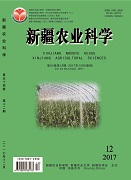|
|
Effects of Shading and Planting Density on Photosynthetic Characteristics of Flag Leaves during Filling Stage of Winter Wheat under Drip Irrigation
ZHANG Yong-qiang, CHENG Xing-wu, Sailihan Sai, XUE Li-hua, LEI Jun-jie
2017, 54(12):
2164-2173.
DOI: 10.6048/j.issn.1001-4330.2017.12.002
【Objective】 To explore the diurnal variation of shading and planting density on photosynthetic characteristic of winter wheat's flag leaf during filling stage under drip irrigation.【Method】Five plant population experiments 450×104 plant/hm2(M1), 525×104 plant/hm2(M2), 600×104 plant/hm2(M3), 675×104 plant/hm2(M4), 750×104 plant/hm2(M5) were conducted in the circumstance of natural light(S0) and shading 50%(S1), respectively, and the leaf area index(LAI), chlorophyll content(SPAD), daily variation of flag's photosynthetic characteristic during filling stage and grain yield were observed to study the effects of different light conditions and population on above indexes of wheat.【Result】The results showed that LAI was descended significantly under S1 treatments, but SPAD was little higher than that of S0. Under shading condition, net photosynthetic rate (Pn), transpiration rate (Tr), stomatal conductance (Gs) were all decreased at different degree while intercellular CO2 concentration(Ci) increased, besides, spike number, grains per spike, 1,000-grain weight and yield were significant lower than those of in natural light treatments, the extent of reduction were in order of 4.14%-11.44%, 5.76%-9.05%, 7.15-22.47% and 16.12%-33.54%.【Conclusion】Comprehensive analysis of various indicators, in 50% shading treatment, M2 treatment (5 million 250 thousand/(plants·hm2)) had better performance in terms of the physiological indexes, the highest yield, 5,250.26 kg/hm2, so it can be used as reference to the field production.
|

